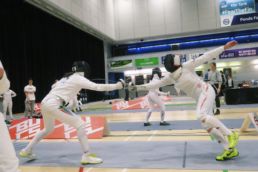There has been a notable increase recently in discussions about women’s sports, particularly football, attributable in part to the success and popularity of events like the Women’s World Cup.
This has contributed to a surge of articles examining the differences between men’s and women’s sport, with ongoing comparisons and criticisms being made on social media. Many of these all too often include the negative stereotyping of female athletes, especially in coverage of less mainstream sports such as fencing.
A summary for those of you unfamiliar with the sport. It consists of 3 distinct disciplines: foil, epee, sabre, each of which has its own blade and its own rules.
The first thing to note is that fencing has been historically male dominated. Prior to 1996, women’s participation in fencing at the Olympic Games was limited to foil, with epee making its debut in 1996 and sabre only being introduced in 2004. This gender imbalance has remained apparent throughout my fencing journey: from my initiation in South Africa in 2013 to my experiences in the UK over the past few years.
In fact, during my time on the University of Bath BUCS fencing team, we hoped to have at least 5 women (to fill a team of 3 minimum and 9 maximum) whereas the men boasted 2 full teams plus substitutes. It is plausible that this kind of situation has given certain unfavourable opinions about women’s fencing the opportunity to circulate and take root.
One of the prevailing assumptions is that women’s fencing – particularly my event, women’s epee – is ‘boring’. This perception stems from the fact that men’s epee tends to be faster and more aggressive, characterised by frequent attacks whilst women’s epee emphasises a more defensive style of play and is generally slower paced.

I would argue, however, that, as in every sport, it is only natural that physical differences between men and women translate into tactical differences. Games are bound to be distinctive. Men typically have greater upper body strength and physical power, hence they aim to dominate the piste and rely more on strength-based attacks such as strong parries (deflections of an opponent’s attack using the blade of the weapon) followed by ripostes (counterattacks made immediately after parrying the opponent’s blade).
Women, on the other hand, often focus on tactical precision, relying on well-timed counterattacks, avoidance techniques and distance control. There isn’t a ‘better’ or ‘worse’ style of play; they are simply different. I believe these distinctions actually add to the overall entertainment value of the sport and appeal to a broader audience as viewers can watch a wide variety of matches, even within the same weapon category.
Additionally, fencing is both a physical as well as a mental sport. Although a man might have a height and weight advantage over a female opponent, this doesn’t provide the same type of advantage he might have in, say, swimming or boxing. Generally, what we see when men and women train against each other that women are more inventive when it comes to getting a point as they can’t always depend on physical strength to secure victory. This highlights the exceptional skill and versatility of female fencers.
While stereotypes of women in fencing may not be as prevalent or discussed as much as those in football or rugby, they do exist. This will hopefully change in the future as more girls are encouraged to take up fencing, resulting in greater gender parity within the sport.
In the meantime, let’s appreciate women’s fencing in its own right and celebrate the differences between men’s and women’s fencing.
Redtorch is a global research, digital & creative agency trusted by the biggest names in world sport making sport more relevant to more people. Click here to find out more about about our work.





